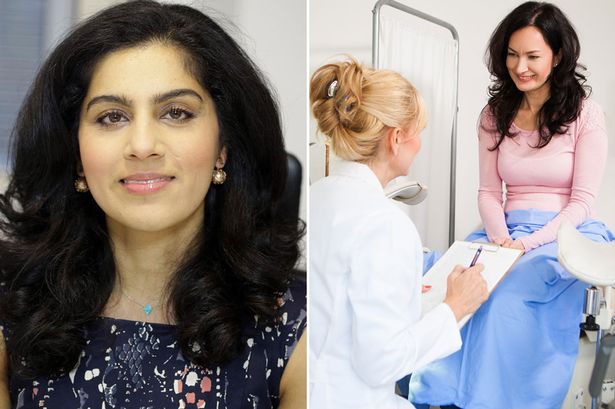We all know that smear tests are extremely important and could end up saving our lives, yet many women still find themselves putting them off.
It’s easy to just pop that letter in a drawer and tell yourself you’ll look at it next week, but it’s vital to get booked in as soon as you can.
Every year, there are about 3,000 new cases of cervical cancer reported in the UK.
About 99.8% of cases are preventable, however fears and misconceptions about smear tests mean some women are still not going to them.
To mark the beginning of Cervical Cancer Awareness Week, INTIMINA UK’s gynaecologist, Dr Shree Datta, has answered the most commonly asked questions on cervical cancer ahead.
What is cervical cancer?
Cervical cancer develops when the cells on your cervix, which lies at the neck of your womb, become increasingly abnormal.
Over time, this develops into a tumour, which may spread into neighbouring structures such as your bladder or bowel.
The cervix has two different types of cells – squamous and glandular, so if abnormalities appear, these may develop into two different types of cancer.
What is a smear test?
You can have your smear test at your GP practice or at a Sexual Health or Gynaecology clinic, ideally when you are not on your period.
We will speak to you before taking your smear in a private clinic room and ask you to undress from the waist down, behind a curtain.
You will lie flat with a towel to cover your hips and pelvis.
During a smear test, we will ask you to draw your knees up and spread them apart.
A doctor or a nurse will gently insert a speculum into your vagina to visualise your cervix, which is at the neck of your womb – at the top of your vagina.
We will take a sample of the cells lining your cervix using a small brush and send these to the lab. When we inspect the cervix, we are checking for any irregularities or abnormalities on its surface.
Once we’ve taken the smear, we remove the speculum and hand you some tissue, allowing you time to relax and get dressed.
All in all, taking a smear takes around 5-10 minutes. Ideally, we would not take a smear if you are on your period or have an infection as this can affect the results reported.
It’s not unusual to get some pink discharge or red bleeding after a smear, which usually disappears within a day or so, but ask for a sanitary towel if you need one.
What is the importance of a smear test?
A smear test involves taking a sample of the cells on your cervix, looking for infection with human papillomavirus (HPV).
This is very common, but can alter the cells in your cervix over time, so if found on your smear, you may be referred to the hospital to see a Gynaecologist for further investigation.
This is important because if abnormal pre-cancer cells on your cervix are not treated, they can eventually turn into cervical cancer.
How often should you get smear tests?
In England, between the ages of 25 and 50, you will be called for a smear test every 3 years. From the age of 50, you’ll be asked to have a smear test every 5 years until the age of 65.
If you experience symptoms such as abnormal bleeding or vaginal discharge, it’s worth speaking to your doctor to see if you need a cervical smear test, even if you are not due for one.
What advice do you have for those nervous or embarrassed about getting a smear test?
A smear test is much easier if you are relaxed and comfortable.
Think about what you are going to wear before attending – we usually ask you to undress from the waist down, including your underwear, but if you have a comfortable skirt on, you can hitch this up.
If you need to take a friend or a minute to position yourself, let the doctor taking your smear test know and we’ll do our best to accommodate your wishes.
If you have had difficulty getting a smear previously, let us know.
How can you make smear tests as easy as possible?
If you’re nervous or embarrassed, talk to the doctor or nurse taking your smear.
They can help to relax and reassure you – remember taking a smear only takes a minute or two.
In some cases, it can be quite difficult to see your cervix fully and we may ask you to make a fist with each of your hands and pop them underneath your bottom.
We also use lots of lubricant to help slide the speculum into your vagina carefully.
Rarely, you may consider taking some paracetamol or Ibuprofen if you find it uncomfortable, or ask your doctor to pause during the procedure so that you can catch your breath.
Focussing on your breathing can also help. Sometimes a change in position or a smaller speculum can be helpful.
The biggest thing to remember is that smear tests are incredibly important, so we will do our best to help you through it!
What happens if you get abnormal results from a smear test?
If your smear test shows high risk HPV, the lab team will also look for changes in the cells of your cervix.
If these are found, you will be invited to see a Gynaecologist in a colposcopy clinic to examine your cervix in more detail.
The first thing to say is that most women don’t have cancer but have changes that occur before cancer develops.
Your smear result will provide an indication of how severe the changes on the cells of your cervix are.
Remember, if the changes are minor, they can go back to normal over time.
Either way, you’ll be referred to Colposcopy so that we can inspect your cervix carefully using different solutions applied onto your cervix.
You may also need a biopsy during this clinic appointment to obtain more information about the cell changes on your cervix.
If no changes are found in the cells of your cervix, you will be asked to have a repeat smear in a year’s time.
Are there any symptoms of cervical cancer?
Yes, there can be. Symptoms to watch for include abnormal bleeding – for example, after sex or in between your periods – vaginal discharge which looks or smells unusual for you and pain during sex.
You may also notice blood in your urine, bloating, a change in your bowel or urinary habits.
What are the risk factors of cervical cancer?
The main risk factors for cervical cancer are having HPV infection and smoking. Having other infections such as chlamydia or HIV can also increase your chance of developing cervical cancer.
Taking the contraceptive pill for over 5 years may also slightly increase your risk of cervical cancer, as well as if you’ve had children.
If another member of your family has had cervical cancer or if you’ve had certain types of cancer, such as kidney or vaginal cancer you are also at higher risk of cervical cancer.
What is the most common age of getting cervical cancer?
Cervical cancer is one of the few cancers that is more common in younger women.
Over half of cervical cancer cases in the UK are seen in women under the age of 45, which is why it’s important to attend when you are invited for a cervical smear.
Can you treat cervical cancer? If so, how?
Absolutely – that’s why it’s so vital to make sure you have your smear tests regularly, when you are notified to do so.
Most cervical cancers are detected at an early stage and can be treated.
The type of treatment given really depends on the extent of the cancer – if detected early, you may have treatment to remove the abnormal area of your cervix, or a hysterectomy.
We will also consider whether your family is complete when thinking about what treatment most suits you.



